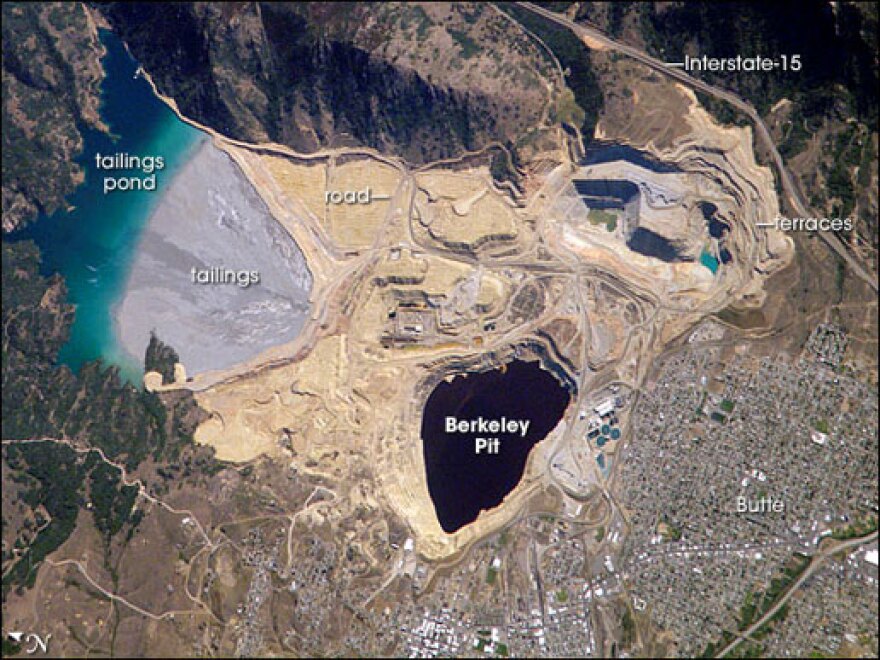This story almost begins on a dark and stormy night in November of 1995, when 342 snow geese landed on Berkeley Pit Lake. Unfortunately, this was no ordinary lake and the story did not end well for these birds.
But they are part of a larger story that actually began for us four months earlier, in July, when my husband, Don, and I first found life in the Berkeley Pit, an abandoned open-pit copper mine situated a mile from our lab at Montana Tech. This is a dual tale of a damaged ecosystem closely connected to Missoula by the Clark Fork River, and of the possibility of finding value in even the most unlikely of places.
Life exists in a wide range of environments including deep-sea vents, salt brines, and thermal pools, as well as those caused by human activities such as mining, industrial accidents, or munitions testing. Nobel laureate Paul Crutzen suggested that we are living in the “Anthropocene,” with humans and human activities acting as a major geological force on the planet. Whether man-made or natural, extreme environments can harbor life forms called extremophiles.
Although the search for new extreme life forms conjures the image of daring adventurers exploring exotic terrestrial, lunar, or Martian landscapes, Berkeley Pit Lake sits in the scenic Rocky Mountains in the heart of Butte, Montana. And the daring adventurers are Don and I, two organic chemists trying to solve some of life’s most persistent problems through the discovery of new antibiotic, anti-inflammatory and anticancer agents.
When colleague Bill Chatham showed us an alga he found growing in the Pit, we decided to launch our own exploration. We were rewarded with three filamentous fungi and quickly decided to “test the waters” for something of interest. Twenty years later, we are still enmeshed in this exploration and with the abandoned copper mine that is the unlikely source of our discoveries.
The Berkeley Pit mine was first opened in 1955 and initially operated by the Anaconda Copper Company and ultimately by the Atlantic Richfield Company until its closure in 1982. Although the pumps were supposed to operate “in perpetuity” to prevent the infiltration of groundwater into this mile-wide, 1500-foot deep hole, they were turned off on Earth Day 1982. Groundwater and rain began to fill the Pit, rising at the rate of one foot a month.
Thirty-three years later, there are over 40 billion gallons of water inexorably rising to the “critical point” where the bedrock meets the alluvial interface and contaminated water will begin to flow into Silver Bow Creek, a major tributary of the Clark Fork of the Columbia River.
Because of its size, toxicity, dynamics and location, Berkeley Pit Lake is part of the largest EPA Superfund site in North America and a potential ecological time bomb. It is also an evolving, dynamic ecosystem and a classic by-product of the industrial age when mining regulations – or lack thereof – allowed such environmental devastation to occur.
The Pit microbes produce a variety of compounds that can be isolated and studied by scientists like us. Just like the discovery of penicillin production by the fungus Penicillium, Pit microbes produce compounds that we hope could be used as antibiotics and maybe even be used to treat inflammatory diseases and some cancers.
But my favorite fungus might have been deposited by one of those snow geese that visited the Pit Lake 20 years ago. It is a yeast that had previously only been found in rectal swabs of geese. It absorbs metals – like copper and iron – from its aqueous surroundings, suggesting its dual potential for bioremediation and secondary ore recovery.
We will continue our explorations as long as our funding allows. These extremophiles and the compounds they produce could be some of the richest “ore” ever mined from the "Richest Hill on Earth."
(Broadcast: "Fieldnotes," 06/05/16. Listen on the radio Sundays at 12:55 p.m., Tuesdays at 4:54 p.m., and Fridays at 4:54 p.m., or via podcast.)

